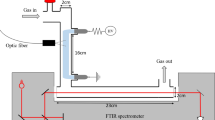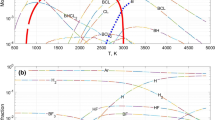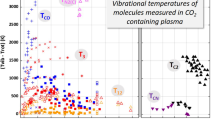Abstract
The production ofSOF 4 initiated by the reaction of F atoms withSOF 2 has been studied in a gas-flow reactor at 295 K for helium bath gas number densities in the range (3.0–27.0)×1016 cm−3. The effect of O atoms on the formation ofSOF 4 has been analyzed in terms of the competing reactionsSOF 3+F→SOF4 andSOF 3+O→SO 2 F 2+F. This analysis leads to the conclusion that the rate coefficients for these two processes are equal within an uncertainty of about 50%. Furthermore, both experiment and calculations indicate that the rate coefficient for reactions between F atoms andSOF 3 is close to its high-pressure limit under the conditions employed. The experiments set a lower limit on this rate coefficient of 5×10−11 cm3 s−1, while calculations based on unimolecular rate theory suggest that it may be greater than 1×10−10 cm3 s−1. These results make it clear that the two reactions shown above cannot explain the relative abundances ofSOF 4 andSO 2 F 2 which are observed inSF 6/O 2 plasmas. This suggests thatSF 2 is a major precursor in the sequence of reactions following the dissociation ofSF 6.
Similar content being viewed by others
References
R. J. Van Brunt,J. Res. Natl. Bur. Stand. 90, 229 (1985).
M. C. Siddagangappa and R. J. van Brunt, Proceedings of the International Conference on Gas Discharges and their Applications, Oxford 1985, p. 247.
I. Sauers, H. W. Ellis, and L. G. Christophorou,IEEE Trans, Electr. Insul. EI-21, 111 (1986).
F. Y. Chu,IEEE Trans, Electr. Insul. EI-21, 693 (1986).
M. C. Siddagangappa, R. J. van Brunt, and A. V. Phelps, Conf. Record of IEEE Int. Symp. on Electrical Insulation, Washington D.C., 1986, p. 225.
R. J. van Brunt, J. T. Herron, and C. Fenimore, inGaseous Dielectrics, Pergamon, New York (1987), p. 163.
R. d'Agostino and D. L. Flamm,J. Appl. Phys. 52, 162 (1981).
A. Picard and G. Turban,Plasma Chem. Plasma Process. 5, 333 (1985).
S. Park, C. Sun, and R. J. Purtell,J. Vac. Sci. Technol. B. 5, 1372 (1987).
I. C. Plumb and K. R. Ryan,Plasma Chem. Plasma Process. 9, 409, (1989).
K. R. Ryan and I. C. Plumb,Plasma Chem. Plasma Process. 8, 263 (1988).
K. R. Ryan and I. C. Plumb,Plasma Chem. Plasma Process. 8, 281 (1988).
K. R. Ryan and I. C. Plumb,Plasma Chem. Plasma Process. 4, 271 (1984).
I. C. Plumb and K. R. Ryan,Plasma Chem. Plasma Process. 6, 11 (1986).
R. L. Brown,J. Res. Natl. Bur. Stand. 83, 1 (1978).
I. Pitt, R. G. Gilbert, and K. R. Ryan (to be published).
I. C. Plumb and K. R. Ryan,Plasma Chem. Plasma Process. 6, 247 (1986).
Author information
Authors and Affiliations
Rights and permissions
About this article
Cite this article
Ryan, K.R. Aspects of the chemistry of SF6/O2 plasmas. Plasma Chem Plasma Process 9, 483–496 (1989). https://doi.org/10.1007/BF01023915
Received:
Revised:
Issue Date:
DOI: https://doi.org/10.1007/BF01023915




